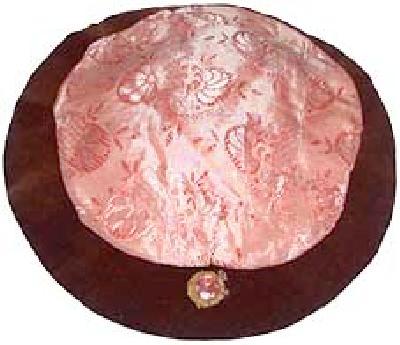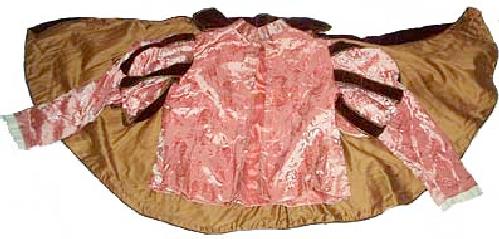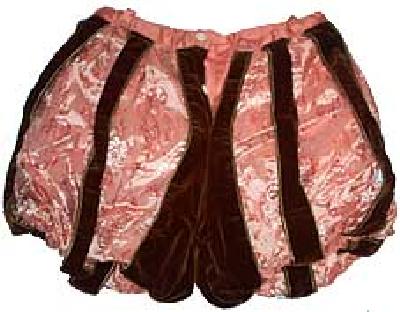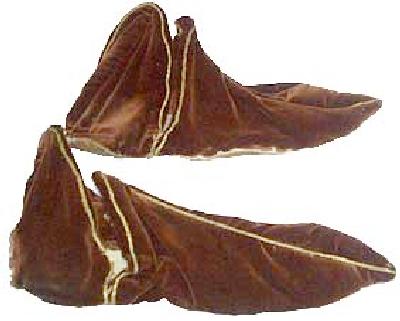
Figure 1.--The hat to this theatrical costume appears to have an oriental influence.


Figure 1.--The hat to this theatrical costume appears to have an oriental influence. |
Vintage clothing from the 16th century is of course very rare. HBC has not yet acquired any images of vintage 16th century clothing. We do have some information on reproductions made for theatrical purposes. Such items of course do not have same authenticity of actual vintage clothing. They do look like acurate reproductions. The costume images that we have acquired is of an English Tudor boy' costume that was used in Shakesperian plays. We do not yet have enough information to indicate the historical accuracy of these garments.
This items appears to be a theatrical costume. As it is a theatrical costume, of course, we can not use it to substantiate period dress in the same senvce of vintage clothing. The costume certainly looks very accurate, but we do not yet know enough about Tufdor-Elizabethan dress to be positive of this.
We guess that the costume was made for a Tudor, Renaissance or Elizabethan play. It could have been used, for example, in a Shakespearian plays. The puffed breeches, especially the short length, suggest that the costume was made for the late 16th or early 17th centuury. We are not sure when it was actually made, probably some time in the 1920s and 1940s.

Figure 2.--This is the pink jacket or doublet and brown cape prepared for the outfit. Click on the image to see the back of the jacket. |
This costume was made in England.
This suit consists of seven items: 1) a lovely brocade or embroidered pink satin jacket or doublet, material shows Oriental influence, handmade and lined in cotton, puff shoulders with brown and gold trimmed velvet strips to decorate, front pop studs to fasten. 2) Amazing heavy brown velvet lined cape trimmed in gold piping - attaches to pink jacket at the shoulders by pop fastening and is a whole semi-circle. 3) Matching pink Chinese-influenced satin trousers with brown velvet and
gold trim decoration, 2 buttons to fasten at front and belt loops, cotton lined. 4) Matching brown velvet purse or bag with belt - pop fastening, fully lined. 5) Brown velvet wide brimmed Tudor hat with pink brocade again, cotton lined. 6: Wonderful brown velvet pointed shoes trimmed in gold with real leather soles (needing a little work at the seams). 7) finally, a pair of Tudor's tights (rather ancient - you may want to use your own instead!) This fun outfit has been lovingly handmade and is of very high quality.

Figure 3.--This is the breeches (the word pants or pants-like garments did not yet exist) prepared for the outfit. We are not sure how common pink was at the time. They were worn with hose or tights like garments. In the 14th century doublets were commonly worn with short skirts and without these breeches. By the late 15th century wearing breeches with hose had become much more common than the skirted doublet without breeches. |
This outfit was made in pink. We are not certain, however, how common pink wa in Tudor or Elizabethan times.
This costume would probably fit a 5-9 year old. Size: Jacket - 30"-32" chest, Shoulder to end of arm: 20", underarm to end of arm: 15". Back of neck to bottom of jacket: 17.5". Trousers/shorts - waist: 26", waist to end of leg (should reach knee length): 14", hat: fits
woman's head (just). Purse: 6" x 6" Belt: adjustable. Shoes: should fit a medium sized child - 9.5" along sole.
Apparently in Tudor England the expression corresponding to the man wearing the pants in the family was in Tudor time tat vthe man wears the doublet and hose. These garments are mentioned in various Shakesperian plays. For example, " I could find in my heart to disgrace my man's apparel and to cry like a woman, but I must comfort the weaker vessel, as doublet and hose ought to show itself courgeous to petticoat." [ As You Like It, 2.4.4-7] Another scene has a wman saying, "Dost thou think, though I am caparisoned like a man, I have a doublet and hose in my disposition?" [As You Like It, Act 3 scene 2] Here Rosalind acknowledges that the men's clothes she is wearing makes her look like a man. Even so, she is behaving very emotionally, behavior Shakespere associates with women.

Figure 4.--This is the footwear prepared fot the outfit. |
Doublet and hose were the typical male attire consisting of a close-fitting jacket and breeches, here Shakeshere uses it to stand for the male as petticoat stands for the female. The doublet could be either a long-sleeved jacket (like the one shown here) or a sleeveless vest. Some doublets, like the one here, ended at the waistline seam. Others had a short, full peplum (small attached skirt) attached. Necklines varied quite a bit. Some doublets had high necklines with a small standing collar. Other oublets had lower necklines with both rounded and square collars. Doublets were usually lined and many were padded. One common device was a stiffened triangular placard underneath the front lacing of the doublet.
placard underneath front lacing.
Navigate the Historic Boys' Clothing Web Site:
[Return to the Main Reniassance reenactment page]
[Return to the Main 16th century page]
[Introduction]
[Activities]
[Biographies]
[Chronology]
[Clothing styles]
[Countries]
[Bibliographies]
[Contributions]
[Essays]
[FAQs]
[Glossaries]
[Satellites]
[Tools]
[Boys' Clothing Home]
Navigate the Historic Boys' Clothing Web chronological pages:
[Return to the Main chronology page]
[The medieval era]
[The 15th century]
[The 16th Century]
[The 17th Century]
[The 18th century]
[The 19th century]
[The 20th century]
[The 21st century]
